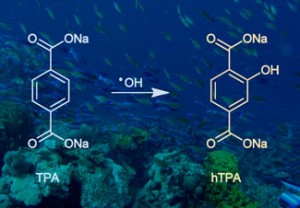The Journal of Environmental Monitoring is now on Twitter – you can follow us at http://twitter.com/JEnvironMonit and tweet @JEnvironMonit


The Journal of Environmental Monitoring is now on Twitter – you can follow us at http://twitter.com/JEnvironMonit and tweet @JEnvironMonit


A study by US scientists has highlighted the need for new respirators for firefighters.
Although firefighters usually wear self-contained breathing apparatus (SCBA) when tackling structural fires, this is a much less common practice when dealing with vehicle fires. The potential health risk from vehicle fire fumes is considered minimal, as the fires are outdoors and are usually extinguished rapidly. In addition, SCBA is cumbersome to wear and takes a long time to put on.
However, Kenneth Fent and his team at the US Public Health Service and the National Institute for Occupational Safety and Health, Cincinnati, have shown that firefighters are actually exposing themselves to almost ten times the acceptable level of 75 volatile organic compounds, including benzene, acetonitrile and acetone.

The measure of risk to a mixture of chemicals was found to be 9.2 times the acceptable amount
Link to journal article
Assessing the risk to firefighters from chemical vapors and gases during vehicle fire suppression
Kenneth W. Fent and Douglas E. Evans, J. Environ. Monit., 2011
DOI: 10.1039/c0em00591f
This month sees the following articles in JEM that are in the top five most accessed:-
Pharmaceuticals and personal care products in effluent matrices: A survey of transformation and removal during wastewater treatment and implications for wastewater management
Rebekah L. Oulton, Tamar Kohn and David M. Cwiertny
J. Environ. Monit., 2010, 12, 1956-1978, DOI: 10.1039/C0EM00068J, Critical Review
Stable isotope fractionation to investigate natural transformation mechanisms of organic contaminants: principles, prospects and limitations
Martin Elsner
J. Environ. Monit., 2010, 12, 2005-2031, DOI: 10.1039/C0EM00277A, Critical Review
Relationship of polychlorinated biphenyls with type 2 diabetes and hypertension
Charles Jay Everett, Ivar Frithsen and Marty Player
J. Environ. Monit., 2011, Advance Article, DOI: 10.1039/C0EM00400F, Critical Review
A suite of microplate reader-based colorimetric methods to quantify ammonium, nitrate, orthophosphate and silicate concentrations for aquatic nutrient monitoring
Stephanie Ringuet, Lara Sassano and Zackary I. Johnson
J. Environ. Monit., 2011, Advance Article, DOI: 10.1039/C0EM00290A, Paper
Degradation of carbon tetrachloride in the presence of zero-valent iron
Jorge S. Alvarado, Candace Rose and Lorraine LaFreniere
J. Environ. Monit., 2010, 12, 1524-1530 DOI: 10.1039/C0EM00039F, Paper
Why not take a look at the articles today and blog your thoughts and comments below.
Fancy submitting an article to JEM? Then why not submit to us today or alternatively email us your suggestions.
![]() Chemistry World are hosting the very first Chemistry World webinar live on 31 January. This will include an active audience in Burlington House and will be free to watch online here.
Chemistry World are hosting the very first Chemistry World webinar live on 31 January. This will include an active audience in Burlington House and will be free to watch online here.
Dr Antony Williams of the RSC and Dr John Shockcor from Waters will be speaking on:
Connecting Chemistry and Mass Spectrometry on the Internet – ChemSpider
Connecting chemistry and mass spectrometry on the internet, discover the powerful combination of modern mass spectrometry and the ChemSpider database of chemical structures for metabolomics research.
For more information visit the RSC publishing blog.
This month sees the following articles in JEM that are in the top five most accessed:-
Stable isotope fractionation to investigate natural transformation mechanisms of organic contaminants: principles, prospects and limitations
Martin Elsner
J. Environ. Monit., 2010, 12, 2005-2031 DOI: 10.1039/C0EM00277A, Critical Review
Elevated antimony concentrations in commercial juices
Claus Hansen, Alexandra Tsirigotaki, Søren Alex Bak, Spiros A. Pergantis, Stefan Stürup, Bente Gammelgaard and Helle Rüsz Hansen
J. Environ. Monit., 2010, 12, 822-824 DOI: 10.1039/B926551A, Communication
Pharmaceuticals and personal care products in effluent matrices: A survey of transformation and removal during wastewater treatment and implications for wastewater management
Rebekah L. Oulton, Tamar Kohn and David M. Cwiertny
J. Environ. Monit., 2010, 12, 1956-1978 DOI: 10.1039/C0EM00068J, Critical Review
Degradation of carbon tetrachloride in the presence of zero-valent iron
Jorge S. Alvarado, Candace Rose and Lorraine LaFreniere
J. Environ. Monit., 2010, 12, 1524-1530 DOI: 10.1039/C0EM00039F, Paper
PFOS or PreFOS? Are perfluorooctane sulfonate precursors (PreFOS) important determinants of human and environmental perfluorooctane sulfonate (PFOS) exposure?
Jonathan W. Martin, Brian J. Asher, Sanjay Beesoon, Jonathan P. Benskin and Matthew S. Ross
J. Environ. Monit., 2010, 12, 1979-2004 DOI: 10.1039/C0EM00295J, Critical Review
Why not take a look at the articles today and blog your thoughts and comments below.
Fancy submitting an article to JEM? Then why not submit to us today or alternatively email us your suggestions.
The Journal of Environmental Monitoring (JEM) is commissioning a special issue reporting significant recent advances in Environmental Nanotechnology for publication in May 2011. Professor Omowunmi Sadik, Director of the Center for Advanced Sensors & Environmental Systems (CASE) at the State University of New York at Binghamton, will be the Guest Editor of this issue.
Through this issue on Environmental Nanotechnology, JEM aims to give wide-spread exposure to current advances from leading investigators and to stimulate further progress in the field based on these new developments. JEM places special emphasis on environmental processes and impacts and contributions are sought (critical and tutorial reviews, full papers, and communications are all welcome) covering these areas.
The journal will begin accepting submissions immediately with an absolute, final submission deadline of January 10th 2011 to meet the May publication date. Manuscripts can be submitted using our online submission service. Please state in your covering letter that your article was submitted in response to the Call for Papers for the themed issue on Environmental Nanotechnology.
This month sees the following articles in Journal of Environmental Monitoring that are in the top five most accessed:-
Elevated antimony concentrations in commercial juices
Claus Hansen, Alexandra Tsirigotaki, Søren Alex Bak, Spiros A. Pergantis, Stefan Stürup, Bente Gammelgaard and Helle Rüsz Hansen
J. Environ. Monit., 2010, 12, 822-824, DOI: 10.1039/B926551A, Communication
Environmental enforcement in the UK
David Stott
J. Environ. Monit., 2009, 11, 470-474, DOI: 10.1039/B810288K, Focus
Terephthalate as a probe for photochemically generated hydroxyl radical
Sarah E. Page, William A. Arnold and Kristopher McNeill
J. Environ. Monit., 2010, 12, 1658-1665, DOI: 10.1039/C0EM00160K, Paper
Spatial and temporal pattern of pesticides in the global atmosphere
Chubashini Shunthirasingham, Catherine E. Oyiliagu, Xiaoshu Cao, Todd Gouin, Frank Wania, Sum-Chi Lee, Karla Pozo, Tom Harner and Derek C. G. Muir
J. Environ. Monit., 2010, 12, 1650-1657, DOI: 10.1039/C0EM00134A, Paper
Degradation of carbon tetrachloride in the presence of zero-valent iron
Jorge S. Alvarado, Candace Rose and Lorraine LaFreniere
J. Environ. Monit., 2010, 12, 1524-1530, DOI: 10.1039/C0EM00039F, Paper
Why not take a look at the articles today and blog your thoughts and comments below.
Fancy submitting an article to JEM? Then why not submit to us today or alternatively email us your suggestions.
Hope may be in sight for the Deepwater Horizon clean up operation as Spanish researchers show the rapid recovery of wild mussel populations following a similarly disastrous oil spill.
In November 2002, the tanker Prestige split in two, disgorging over 60 000 tonnes of oil into the Atlantic Ocean. The Galician coastline, Europe’s largest producer of mussels, was one of the worst affected areas. Miren Cajaraville led a team at the University of the Basque Country, Leioa, to assess the impact of the spill on the reproductive capabilities of wild mussel populations.
Mussels are commonly used as a gauge of marine pollution levels as they are inactive and do not move to feed, so accumulate high levels of contaminants from their environment. Cajaraville monitored the levels of a protein that control the development of sex cells in females along with other indicators of abnormality, such as premature cell death and abnormal reproductive organ development to determine the effect of the oil-contaminated waters on the mussels.
Read the full story here
Link to journal article
Effects of the fuel oil spilled by the Prestige tanker on reproduction parameters of wild mussel populations
Maren Ortiz-Zarragoitia, Larraitz Garmendia, María Carmen Barbero, Teresa Serrano, Ionan Marigómez and Miren P. Cajaraville
J. Environ. Monit., 2010, DOI: 10.1039/c0em00102c
A sensitive probe to monitor hydroxyl radicals in water has been developed by a team of Swiss and US scientists.
Hydroxyl radicals are high-energy oxidants that are important in the biology of ageing and radiation damage, as well as in environmental chemistry. In natural water systems, the radicals are produced photochemically from nutrients such as nitrates or nitrites and pollutants such as dissolved organic matter. And accurately measuring hydroxyl radical concentrations can help understand the fate of pollutants.
fate of pollutants.
Current hydroxyl radical probes, such as benzoic acid, often have limited sensitivity, require long irradiation times or high concentrations of the probe, which can affect the sample. Now Kristopher McNeill at the Swiss Federal Institute of Technology (ETH) in Zurich and colleagues at the University of Minnesota in Minneapolis have discovered that terephthalate is a more sensitive probe for hydroxyl radicals in aquatic environments.
Terephthalate picks up an OH radical to form fluorescent hydroxyterephthalate
Click here to read the full story
Link to journal article:
Terephthalate as a probe for photochemically generated hydroxyl radical
Sarah E. Page, William A. Arnold and Kristopher McNeill, J. Environ. Monit., 2010, 12, 1658
DOI: 10.1039/c0em00160k
The RSC currently presents around 60 prestigious Prizes and Awards annually to scientists in all the main chemical science disciplines allowing for the greatest range of scientists to be recognised for their work; individuals, teams and organisations working across the globe.
There are nine categories of awards including specific categories for Industry and Education so whether you work in business, industry, research or education recognition is open to everyone.
Our Prizes and Awards represent the dedication and outstanding achievements in the chemicals sciences and are a platform to showcase inspiring science to gain the recognition deserved.
Do you know someone who has made a significant contribution to advancing the chemical sciences?
View our full list of Prizes and Awards and use the online system to nominate yourself or colleagues.